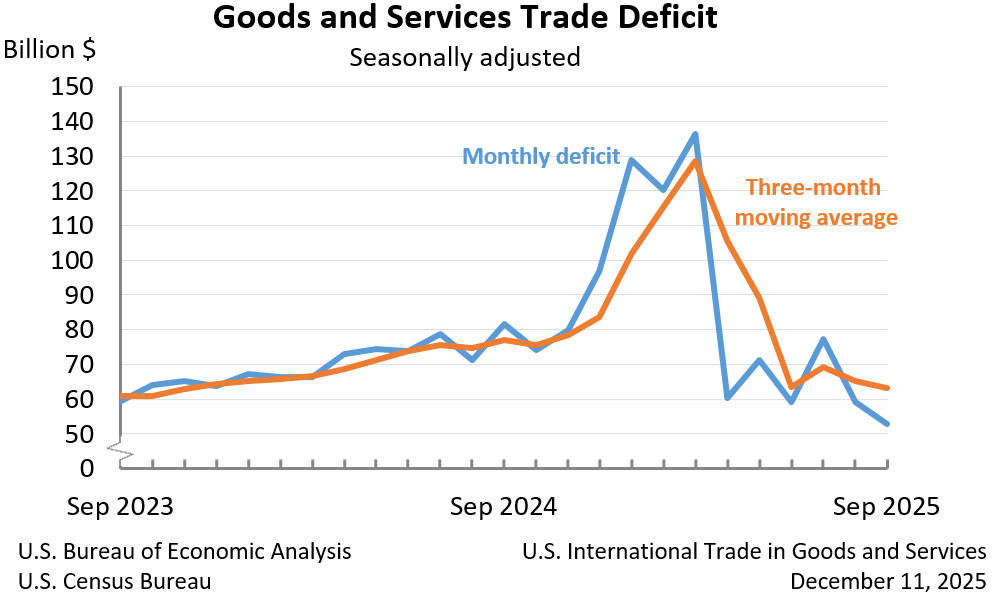Bureau of Economic Analysis
U.S. International Trade in Goods and Services, September 2025
The U.S. goods and services trade deficit decreased in September 2025 according to the U.S. Bureau of Economic Analysis and the U.S. Census Bureau. The deficit decreased from $59.3 billion in August (revised) to $52.8 billion in September, as exports increased more than imports. The goods deficit decreased $7.1 billion in September to $79.0 billion. The services surplus decreased $0.6 billion in September to $26.2 billion.
Principal Federal Economic Indicators
Noteworthy
The Latest
Consumer Spending Falls In December
Personal income rose 0.3 percent in December, the same increase as in November. Wages and salaries, the largest component of personal income, rose 0.1 percent in December after rising 0.6 percent in November.
Personal Income and Outlays, December 2014
Personal income increased $41.3 billion, or 0.3 percent, and disposable personal income (DPI) increased $35.8 billion, or 0.3 percent, in December, according to the Bureau of Economic Analysis. Personal consumption expenditures (PCE) decreased $40.0 billion, or 0.3 percent. In November, personal income increased $47.2 billion, or 0.3 percent, DPI increased $34.2 billion, or 0.3 percent, and PCE increased $58.8 billion, or 0.5 percent, based…
GDP increases in Fourth Quarter
Real gross domestic product (GDP) increased 2.6 percent in the fourth quarter of 2014, according to the “advance” estimate released by the Bureau of Economic Analysis. In the third quarter, real GDP increased 5.0 percent. For the full year 2014, real GDP rose 2.4 percent after rising 2.2 percent in 2013.
Fourth-quarter GDP highlights The increase in GDP in the fourth quarter reflected the following:
Gross Domestic Product, 4th quarter and annual 2014 (advance estimate)
Real gross domestic product -- the value of the production of goods and services in the United States, adjusted for price changes -- increased at an annual rate of 2.6 percent in the fourth quarter of 2014, according to the "advance" estimate released by the Bureau of Economic Analysis.
Widespread Growth Across Industries Continues in Third Quarter 2014
Real gross domestic product (GDP) increased at an annual rate of 5.0 percent in the third quarter of 2014, reflecting positive contributions from 20 of 22 industry groups. The private goods- and services-producing industries, as well as the government sector, contributed to the increase.
Introducing the New BEA Health Care Satellite Account
Total health care spending reached 17.4 percent of gross domestic product (GDP) in 2013, and that share is expected to continue to grow significantly, according to the Centers for Medicare and Medicaid Services. Given this trend, it is critical to develop an understanding of what those increased expenditures represent. Are the increases attributable to rising costs of treatment or more individuals receiving medical care? What medical…
Gross Domestic Product by Industry, 3rd quarter, 2014
Real gross domestic product (GDP) increased at an annual rate of 5.0 percent in the third quarter of 2014, reflecting positive contributions from 20 of 22 industry groups. The private goods- and services-producing industries, as well as the government sector, contributed to the increase. Finance and insurance; mining; and real estate and rental and leasing were the leading contributors to the increase.
New Health Care Statistics to be Released Jan. 22
New statistics tracking the changes in the prices to treat different diseases are slated to be available Thursday, Jan. 22 when the Bureau of Economic Analysis publishes a new health care satellite account report.
Arts and Cultural Production Satellite Account
This release is available as a PDF download.
Spending on Arts and Cultural Production Continues to Increase
Nominal value added from all arts and cultural production (ACP) industries- a measure of this sector’s contribution to gross domestic product (GDP) – increased 3.8 percent, or $25.8 billion in 2012, according to new statistics released by the Bureau of Economic Analysis (BEA). Value added for ACP accounted for 4.3 percent, or $698.7 billion, of GDP.




